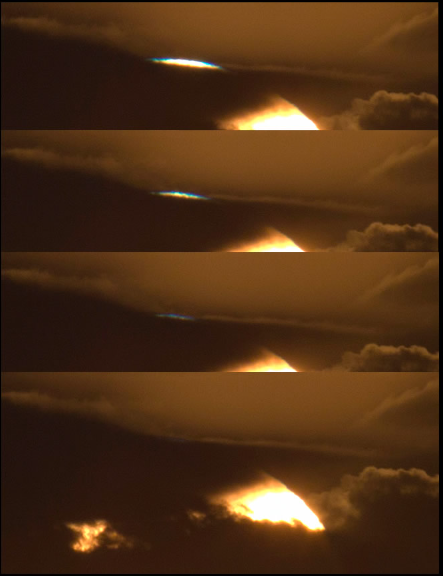Cloud-Top Blue Flash - OPOD
Cloud-Top Blue Flash: A Rare and Mysterious Atmospheric Phenomenon
Have you ever witnessed a cloud-top blue flash? These captivating events, captured by photographer Steve Mattan at Sunset Beach, Cape May, New Jersey, are a true spectacle of nature. As the sun sinks below the horizon, its upper limb disappears behind a cloud, resulting in a mesmerizing display of colors. The shrinking sliver of the sun first develops a vibrant green hue and then transitions into deep blues before eventually being extinguished. These cloud-top flashes are not only rare but also occur much higher above the horizon than ordinary flashes, making them a topic of intrigue for atmospheric optics enthusiasts.
Cloud-top flashes, like all mirages, are formed due to the phenomenon of refraction. Refraction occurs when light passes through air layers with different temperatures, causing the light rays to bend. In the case of cloud-top flashes, the mirage is created when cooler and denser air exists below warmer air. This stark contrast in temperature creates strong density gradients, which lead to the refraction of light.
One distinctive feature of cloud-top flashes is their occurrence at higher altitudes compared to other mirages. While most mirages are observed near the horizon, cloud-top flashes can manifest further away. Additionally, these flashes often display a stunning blue color instead of the typical green associated with mirages. The reason behind this variation lies in the phenomenon of atmospheric scattering.
Atmospheric scattering refers to the process by which light is dispersed or redirected as it interacts with particles in the atmosphere. Shorter wavelength colors, such as violets, blues, and greens, are more susceptible to scattering than longer wavelength colors like reds and oranges. When it comes to cloud-top flashes, the atmospheric scattering of shorter wavelength colors is much weaker away from the horizon. As a result, more blue light is transmitted, leading to the observed blue flashes.
The occurrence of cloud-top blue flashes is still not fully understood, adding an air of mystery to these captivating events. While the basic principles of refraction and atmospheric scattering explain the phenomenon, there are still unanswered questions regarding the specific conditions that give rise to these flashes. Further research and observation are necessary to unravel the intricacies of cloud-top blue flashes.
In conclusion, cloud-top blue flashes are a rare and awe-inspiring atmospheric phenomenon. These mirages, formed through the refraction of light across air layers with different temperatures, occur higher above the horizon than ordinary flashes. The weaker atmospheric scattering of shorter wavelength colors away from the horizon results in the transmission of more blue light, leading to the striking blue flashes observed during cloud-top events. Although the exact mechanisms behind these flashes remain elusive, they continue to captivate the imaginations of those fortunate enough to witness them.
Rare Cloud-Top Blue Flash ~ Captured by Steve Mattan at Sunset Beach, Cape May, New Jersey. The sun is well above the horizon, its upper limb sinking behind cloud. The shrinking sliver first develops green and then deep blues before being extinguished. Cloud-top flashes are rare, occur much further from the horizon than ordinary flashes and are not wholly understood. This is a fine example. All images ©Steve Mattan, shown with permission

Cloud top flashes are mirages. Like all mirages, they result from refraction across the strong density gradients between air layers of different temperature. Parts of the mirage are vertically magnified, separating colours which are seen as a flash.
Cloud-top flashes are a form of mock-mirage produced when cooler denser air is below warmer.
Nearly all mirages are close to the horizon. Cloud top flashes sometimes occur higher up and blue rather than green flashes can be the result. Atmospheric scattering of shorter wavelength violets, blues and greens is much weaker away from the horizon thus giving more transmitted blues. The light of normal flashes is more denuded of blues yielding – at most – a green or yellow-green.
My thanks to Andrew Young for his very helpful comments.

Note: this article has been automatically converted from the old site and may not appear as intended. You can find the original article here.
Reference Atmospheric Optics
If you use any of the definitions, information, or data presented on Atmospheric Optics, please copy the link or reference below to properly credit us as the reference source. Thank you!
-
<a href="https://atoptics.co.uk/blog/cloud-top-blue-flash-opod/">Cloud-Top Blue Flash - OPOD</a>
-
"Cloud-Top Blue Flash - OPOD". Atmospheric Optics. Accessed on November 26, 2024. https://atoptics.co.uk/blog/cloud-top-blue-flash-opod/.
-
"Cloud-Top Blue Flash - OPOD". Atmospheric Optics, https://atoptics.co.uk/blog/cloud-top-blue-flash-opod/. Accessed 26 November, 2024
-
Cloud-Top Blue Flash - OPOD. Atmospheric Optics. Retrieved from https://atoptics.co.uk/blog/cloud-top-blue-flash-opod/.